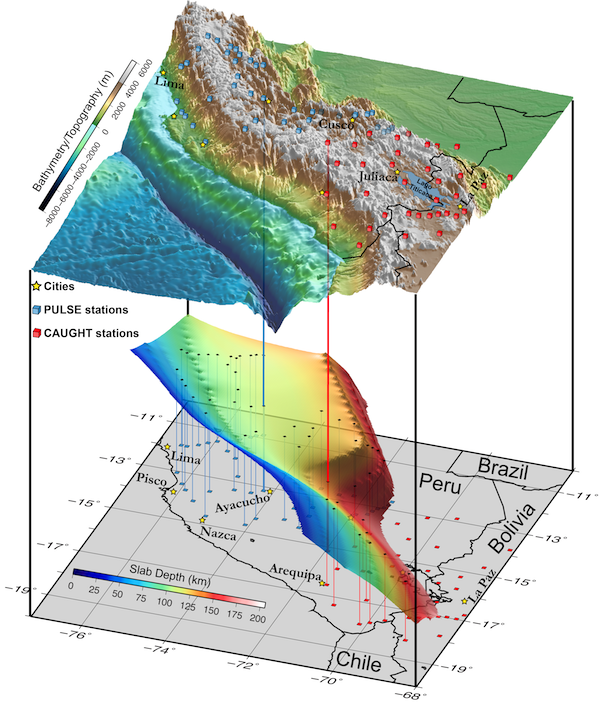2012 IRIS Workshop
PULSE: The Peru Lithosphere and Slab Experiment
L.S. Wagner: UNC-Chapel Hill, M.D. Long: Yale University, S.L. Beck and G. Zandt: University of Arizona, H. Tavera: Instituto Geofisico De Peru
Topography and geometry of the subducted Nazca plate beneath the central Andes. Blue and red squares and cubes show PULSE and CAUGHT station locations respectively. Thin vertical blue and red lines show the projection of station locations on the downgoing plate (slab pierce points are shown as black diamonds). The slab geometry is contoured from Cahill and Isacks (1992). For reference, major urban centers are indicated by yellow stars.

Full-resolution graphics file in original format: 0071.jpg
Flat slab subduction has become a popular concept used to explain a wide host of geological observations including the cessation of arc volcanism, inland thick-skinned deformation, ignimbrite flare-ups, and the formation of high plateaus. In order to study both the causes and consequences of this unusual subduction geometry, we have deployed the 40 broadband seismic stations of the PerU Lithosphere and Slab Experiment (PULSE) across central and southern Peru. This installation was completed in May, 2011, and will remain until until May, 2013. PULSE covers the southern half of the broad Peruvian flat slab (Cahill and Isacks, 1992), whose formation may be correlated with the subduction of the overthickened oceanic crust of the Nazca Ridge. If this is correct, then the southward migration of the subduction point of the Nazca Ridge may also indicate a southward younging of the flat slab geometry. We will perform a variety of analyses to image the crust and mantle lithosphere above the Nazca plate, including local and teleseismic body wave tomography, ballistic and diffuse Rayleigh wave analyses, receiver functions, and shear wave splitting studies. Systematic north-south trends may elucidate ongoing effects of flat slab subduction, including cooling of the overriding plate, hydration of the mantle wedge, and/or metasomatization of the mantle lithosphere. The PULSE deployment extends south up to the transition from flat to normally dipping slab subduction. Immediately south of the PULSE deployment are the 50 broadband seismic stations of the CAUGHT deployment (Central Andean Uplift and the Geodynamics of High Topography: Wagner, Beck, and Zandt). The CAUGHT stations were installed in October, 2010, and will record until August, 2012. Combining these two data sets will allow us to study this transition in slab dip, which also roughly coincides with the change in orogenic structure from broad Altiplano Plateau to narrow “normal” Cordillera.
Acknoweldgements: Funding for the PULSE project comes from NSF-Geophysics award #0944184. CAUGHT is funded by NSF-Continental Dynamics award #0908777. All of this would not be possible without the generous support of Dr. H. Tavera at the Instituto Geofisico de Peru, and the hard work of the many field crews (students, drivers, and colleagues) who have helped make these deployments a reality.
For further reading: Cahill, T., Isacks, B.L., 1992. Seismicity And Shape Of The Subducted Nazca Plate. Journal Of Geophysical Research-Solid Earth 97, 17503-17529.
Keywords: andean_tectonics, flat_slab_subduction, passcal_deployments
